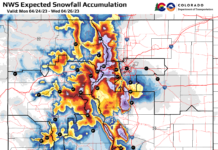by Marissa Lorenz
County Manager Ed Moyer continues to update the Grand County Board of County Commissioners (BOCC) about water temperatures and flows while data still shows alarming trends.
In spite of coordinated efforts between the County, Denver Water, Northern Water, the Colorado River Water Conservation District, and others, river flow remains low and temperatures continue to spike with dangerous highs.
On Wednesday, June 23, the Kremmling gauge recorded a water flow rate of 478 cfs (cubic-feet-per-second), nearly half the average flow of 837 cfs, given 58 years of data, and well below the highest recorded flow of 8,270 cfs in 2011.
Water temperatures continue to peak at 65 degrees Fahrenheit or higher on a daily basis, with a temperature of over 72 degrees recorded on Monday, June 21. Temperatures over 65 degrees are considered dangerous for a fishery; risk of suffocation increases for fish as temperatures climb above that threshold.
“We’ve seen crazy water temps with readings over 70 degrees in Kremmling,” Moyer related to Commissioners on Tuesday.
He acknowledged that there had been documented fish kill near the confluence of the Colorado and the Blue Rivers. “It’s the perfect storm,” he described, “with the high temperatures we’ve had in the last few weeks and the low water flows.”
Reporting on mitigation efforts at last week’s regular meeting of the BOCC, Moyer indicated that Denver Water had bypassed about 450 additional cfs of water in the Fraser Basin in the second week of June, allowing it down Vasquez and Ranch Creeks to eventually work its way into the Colorado River. He noted that that number had been reduced to 150 cfs as the peak runoff from snowmelt had already passed.
Denver Water was also reported to be increasing releases on June 15 and 16 out of Williams Fork Reservoir, in order to help address alarmingly high river temperatures near Kremmling. Moyer indicated that the water entity had only been releasing 17 cfs out of the water storage facility in hopes to allow it to fill as much as possible in a below average snowpack year.
“They’re going to do some releases in the morning, from 9:00 a.m. to 3:00 p.m.,” he explained, “so it hits the lower section in the afternoon. They will take it up to 125 or 150 cfs, then reduce it again to 17 [cfs] later in the day.”
Moyer indicated that Windy Gap (a Northern Water facility) had been pumping water into the Colorado at their minimum level of 200 cfs.
He was negotiating the possibility of also doing adjusted flows from that facility, “ramping up” their release to 300 cfs during mid-day hours and reducing it during other time periods “so the additional flows hit the lower portion [of the Colorado River near Kremmling] at the right time to benefit water temperatures, fisheries, and rafters.”
However, at this Tuesday’s BOCC meeting, Moyer noted that Windy Gap’s pumps had been turned off, as of the previous day.
Moyer reported that staff continued to work closely with the County’s Learning by Doing partners-all members of an Inter-Governmental Agreement (IGA) designed to work “in cooperation, not conflict, (…) with a shared vision of river health,” responding cooperatively to “setbacks in Grand County’s aquatic environment”-and other water partners to address the continued high water temperatures in the Colorado River near Kremmling.
“We’re trying to get water out at critical periods,” Moyer stated, “timing releases so it hits near Kremmling in the afternoon.”
The Manager observed that Denver Water had increased water release out of Dillon Reservoir to 200 cfs, helping to fill Green Mountain Reservoir and “knock down the substitution bill a little.” -The “substitution bill” referring to an agreement between water storage facilities to replace water diverted for “out-of-priority operation obligations” in years where there is minimal stream flow and demand exists at another facility.
In this case, Green Mountain Reservoir will not fill this year and, in order to meet its storage rights and obligated release to the Colorado River system, additional water releases will come from Wolford and Williams Fork Reservoirs, according to Moyer.
But to address the immediate concern, the County awaits the Shoshone Outage Protocol (SHOP) to go into effect, a negotiated agreement by which entities with junior water rights cede to the senior rights of the Shoshone Power Plant near Glenwood Springs, thereby allowing water to continue flowing downstream and not be so largely diverted to the Front Range or other claimants.
Moyer explained that the power plant is not operating at full capacity right now, but that the SHOP agreement of 2016 would allow the full call of 1,250 cfs to take place.
“The Shoshone Outage Protocol will kick in, and everyone will treat that as if the call was still on the river.”
The SHOP call would mean additional water would be released from Wolford and Williams Fork Reservoirs, would be pumped
into the Colorado at Windy Gap, and that more water would be bypassed by the Moffat system.
But as Moyer notes, “If we’re talking about these issues now, what are July and August going to look like from a water standpoint? We’re in a world of hurt.”
Everyone affected recognizes that the Shoshone call will only act as a temporary band-aid. If temperature, drought, and snowpack trends continue in the way that they have been-hotter and drier-water entities and those dependent on their management will have to continue their water juggling act into the future.
For current river information, go to waterdata.usgs.gov/. To learn more about the health and care of Grand County’s fisheries, visit the Headwaters Trout Unlimited Chapter at coheadwaters.org/. For more information on Learning by Doing, they’re working together to protect water and aquatic life, go to www. grandcountylearningbydoing.org/.







